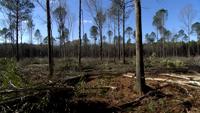CAMBRIDGE, MD - While Delmarva’s persistent drought has brought challenges for farmers and forests alike, it has also provided unexpected opportunities for restoration efforts at the Blackwater National Wildlife Refuge in Dorchester County.
Scientists at the refuge report that a thinning project designed to reduce pine density has progressed faster than anticipated due to the dry conditions. On a 100-acre plot dominated by loblolly pines, approximately 75% of the trees have been cleared, putting the team ahead of schedule.
“The canopy was completely dominated by loblolly pine, so the goal of this thinning project is to reduce those loblollies and allow some of the native hardwoods like oak species to really start to establish and grow into this future forest,” said Matt Whitbeck, supervisory wildlife biologist at Blackwater National Wildlife Refuge.
Tree removal, typically completed by early fall, is only the first step in the process. Normally, wetter conditions in late fall and winter slow the work, but this year’s record drought has extended the timeline for clearing.
“So we typically stop until it starts getting wet, which is typical for winter. But here we are in the middle of December, and it’s still really dry. And so this record drought that we find ourselves in has a lot of detrimental impacts to what we’re doing, but it’s also really allowing us to continue to get this work done long before we normally would,” Whitbeck explained.
The early progress means the refuge could begin step two—controlled burns—sooner than expected if winter weather cooperates. These burns are crucial for creating habitats that support a diverse range of wildlife.
“The young forest that will come up here in the next few years is fantastic for nesting turkeys, bobwhite quail, prairie warblers, chats, thrashers, woodcock—there’s a whole litany of species that need an early successional forest,” Whitbeck said.
Officials at Blackwater National Wildlife Refuge plan to begin the controlled burns in the spring, further advancing efforts to create a healthier, more balanced ecosystem.



